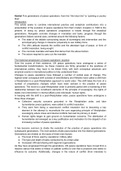Samenvatting
Complete Summary of Politics Of Reconstruction And Intervention
Complete summary of the literature and readings for the course Politics of Reconstruction and Intervention. The summary contains the following: - Five generations of peace operations, Kenkel - At War's End: Chapter 1 and 2, Paris - Managing Contradictions: The Inherent Dilemmas of Postwar Stat...
[Meer zien]




